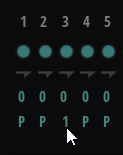User Page
The User page offers a user phrase editor with which you can create and save your own phrases.
The following additional parameters are available on the User page:
- Arp Mode
-

- Wrap
-

- Key Replace
-

User Phrase Editor

-
The topmost row contains the velocity curve. The parameters for the individual velocity steps Step On/Off, Step Legato, Step Transpose, and Step Key Select are displayed above it.
-
Below the velocity curve, you can find the controller curves for MIDI controllers 111, 112, and 113.
-
The modulation rows to the right allow you to use the controller curves as modulation sources.
- Step On/Off
-
Activates/Deactivates the corresponding step.
- Step Legato
-
Activates legato between this step and the following step.
- Step Transpose
-
Allows you to transpose the step by the specified number of semitones.
- Step Key Select
-
The arpeggiator scans the keyboard and writes the keys that you press into a note buffer. Depending on the selected Key Mode, this note buffer is sorted either by pitch or in the order in which you play the keys. Key Select allows you to play back a defined key from the note buffer. You can set up Key Select for each individual step, which allows you to create very elaborate phrases.
NoteKey Select cannot be used if Arp Mode is set to Step or Chord.
-
To switch between the available Key Select values for a step, click the value, and drag up/down, or use the scroll wheel.
The following options are available:
-
P (Phrase) plays the note of the user phrase, according to the selected mode, for example, Up, Down, Up/Down 1, etc.
-
The settings 1 - 8 play the corresponding keys from the note list. Which key is played depends on the Key Mode setting. For example, if Key Mode is set to Sort, setting 1 plays the lowest key.
-
L (Last) always plays the last key from the note buffer. Depending on the Key Mode, this is the highest note or the last note in the note buffer.
-
A (All) plays all keys from the note buffer as a chord.
-

-
MIDI Controller Lanes
The MIDI controllers 110, 111, and 112 from the three controller lanes are sent to the modulation destinations. When you export a recorded sequence, these controller values are also exported. This means that, once you add the exported MIDI sequence to the sequencer, you can deactivate the arpeggiator and play the notes and controller values using the sequencer.
The three modulation rows on the right allow you to use the three controller curves as modulation sources.